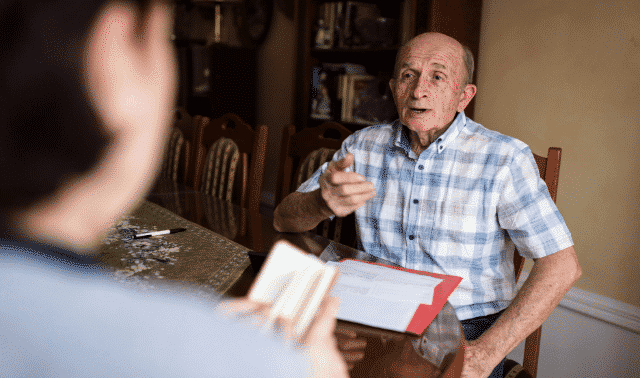Sign up for the Family Tree Newsletter Plus, you’ll receive our 10 Essential Genealogy Research Forms PDF as a special thank you!
Get Your Free Genealogy Forms
"*" indicates required fields

Conducting the interview in itself is an opportunity to enjoy the meaningful interactions that are the heartbeat of a family. These need-to-know tips for talking to family will help you make the most of that gift and offer something even better in return: the unique story of your family.
All tips written by Karen Edwards, unless otherwise noted.
1. Decide on the scope.
“Where to start on an oral history project depends on what you want from it,” says Doug Boyd, president of the Oral History Association and director of the Louis B. Nunn Center for Oral History at the University of Kentucky. “Do you want all family stories, or just certain aspects of them?”
For example, you might decide to ask about relatives who are WWII vets, or focus on family members who emigrated. You could focus on a particular research problem (such as unidentified photos) or let the occasion determine your focus (a holiday party is ripe for asking about family recipes or Christmases past). Once you know the scope of your project, then you can decide who to interview and what kinds of questions to ask.
2. Consider everyone.
Don’t just focus on older folks for your interviews. Cousins in your own generation may have heard stories you didn’t, or received caches of old photos. Your siblings may remember different stories about how your parents met or your childhood home. Also think about family friends, neighbors, coworkers and clergy.
3. Prioritize your interview list.
Determine whom you’ll need to interview and prioritize it according to risks, suggests Pamela Henson, historian with the Institutional History Division of the Smithsonian. “Oral historians use the ‘actuarial imperative,’ that is, who’s likely to die the soonest— which is often the oldest,” she says. But anyone facing memory loss or serious health challenges would move up the list. Boyd adds that you also should prioritize anyone who may be moving away soon. Of course, folks in town for the holidays also are prime candidates.
4. Schedule an appointment.
Procrastination is one of the biggest obstacles you’ll face in interviewing, so just do it: Pick up the phone or email the relative you want to interview and schedule an appointment. It helps to introduce yourself as “so-and-so’s oldest daughter” if the person knows who your mom or dad is, and say, “I’m interested in our family history, and I’d like to ask you a few questions about it when you have some time.”
You also could have another relative you both know make the first contact, and then follow up with a call and say, “I’m the person Jill called you about.” If you live in different time zones, make sure you’re clear on the interview time in both your and your source’s locations.
Tip provided by Lisa Louise Cooke
5. Prepare and practice your questions.
Because time is limited, preparation is key to interview success. You may get only one shot at each family history interview, so careful preparation will ensure you don’t miss an important scoop.
Start by determining the goal of your interview. What’s the outcome you want? What information is most important for you to obtain? Next, make a list of topics that you’ve been eager to learn more about and develop questions that address them. Write specific, open-ended questions covering areas such as the relative’s military service, first job, family traditions, childhood memories, education, marriage, parents and grandparents, siblings, and so on.
Finally, group your questions by topic and prioritize them. You might not get to ask everything, so be sure you know which questions are the most important to cover. And remember, if you ask a question that can be answered with a “yes” or a “no,” that’s the response you’ll get.
As a genealogy speaker, I practice and record myself giving presentations to work out the kinks. If you’re a rookie interviewer, do what lecturers do and conduct a test run. Invite a friend to help you do a practice interview. Not only will you learn what works well and what doesn’t, but you will also learn more about your buddy and ensure your recording devices work properly.
Tip provided by Lisa Louise Cooke
6. Gather your supplies.
As with any type of project, having the right tools makes the job easier. Here’s a list of equipment to consider.
Tip provided by Lisa Louise Cooke
7. Introduce yourself.
Shy about approaching relatives you don’t know? “Send a note introducing yourself and describing your project,” Henson says. Handwritten notes work best for older relatives, but you can email or text more recent generations. “Follow up with a phone call where you arrange a time to meet,” Henson adds. If the relative says “no” to an interview, be respectful of that.
8. Try a pre-interview meeting.
For a formal or lengthy interview, you might meet briefly beforehand. “Don’t tape record or take notes. Just meet over coffee or tea and chat. You want to establish rapport and build their trust, so when you do meet for an official interview, the awkwardness is gone,” Boyd says.
9. Come up with questions.
Consult Family Tree Magazine‘s list of family history interview questions and prompts. Also turn to other online resources such as the Smithsonian’s oral history guide and the UCLA Center for Oral History Research.
10. Research your relatives.
To help you formulate questions, learn as much as you can about each person on your list. Review your research for information. Check old newspapers for articles mentioning births, weddings, graduations, sports, military service and other activities. Look in old yearbooks. Your notes will be handy memory-joggers for the interview. “Sometimes, if an older relative can’t remember the name or a date, they freeze, then get frustrated,” Henson says. If you can provide the information, the interview can continue.
11. Research the time and place, too.
Research what’s taken place in the world during your relative’s lifetime, both locally and on a broader scale. Ask about historic events, such as the hometown’s bicentennial parade, the Vietnam War and the Blizzard of ’78. Ask what life was like at the time, how your relative participated or what the event meant.
12. Go off-script when needed.
Prepare interview questions based on your genealogy research and any information missing from your family tree, but be ready to go off-script.
“The most important questions aren’t the ones you’ve prepared, they’re the follow-up questions you ask during the interview,” Boyd says. For example, if you ask Aunt Mary what career path she followed, the response may be teacher—but don’t stop there. “Ask her what grade she taught, ask about the students, what the classrooms were like,” Boyd says. “Keep asking until you can’t think of another question to ask.”
Your list likely includes questions you must have the answer to. To make sure you cover them, Henson suggests putting stars by those questions and asking them first.
13. Don’t send questions ahead of time.
“You can tell the person what general topics you’ll cover,” Henson says, “but if you send a list of your questions, you’ll likely get rehearsed responses.”
Still, knowing the kind of subject matter you’re interested in will help your relative start thinking about those times and places. He may even gather some family photos or documents for you. “It also may help relatives who are hesitant about doing an interview,” says Henson. “They might be more comfortable talking with you if they know in advance the topics you’ll ask about.”
14. Bring along visuals.
Gather old family photographs and documents to bring to the interview or family get-together. “Photographs can spark memories,” says Henson. You might show your relative a photo of the house where he or she grew up, and ask her to tell you about the house and the neighborhood. “If people are pictured,” Henson says, “ask your relative, ‘Who are these people?’”
Maps also can be great prompts, Boyd says. Especially if an area has been redeveloped, destroyed by a natural disaster or changed in some other way, ask about the area as it existed before, and how those changes happened.
15. Choose your technology.
You’ll want to record an interview, whether on audio or video. If using a digital recorder, ideally, you and your relative will be miked. You also could use two strategically placed microphones. “If you record with your smartphone, know how much space you have on it,” Boyd cautions. “You don’t want to be in the middle of an interview and find you’ve run out of space.” And do a test recording in advance to make sure everything’s working smoothly.
Planning to video record the interview? Make certain your subject is well lit, Boyd says. And it’s often a better interview if you ask your relative to do something—perhaps prepare a recipe or work in his woodshop—“so it’s not just a talking head,” says Boyd.
16. Be ready to capture spontaneous moments.
Even if you’re just headed to a family gathering, you want to be able to hit Record when Dad starts storytelling over dessert. A digital recorder or your smartphone with an app such as Easy Voice Recorder (Android) is handy for these spontaneous opportunities. If possible, use a microphone attachment on your phone, or a Bluetooth microphone that’s compatible with the app. Some recording apps, such as StoryVault, automatically upload the digital file to your online account at the companion site. But make sure you also have a copy of the file on your device in a standard format (such as WAV or MP3).
Check Boyd’s blog, Digital Omnium, for reviews of smartphones, attachments and other interview technology.
17. Prepare for the worst.
Bring charging cords and extra batteries for your devices, as well as a printed copy of your questions.
18. Start on the right foot.
“A good way to begin is ‘Tell me about yourself,’” Boyd suggests. To keep building trust with your interviewee, make eye contact as you talk. Sit forward to show your interest and ask follow-up questions about the people, places and events your relative mentions.
19. Ask the tough questions, but know when to quit.
Questions about a traumatic event in the relative’s life, such as military service or a loved one’s death, may be difficult. That doesn’t mean you should shy away from them, Boyd says. You may find your relative wants to discuss a time of struggle, and building trust makes him more likely to respond. But tread with sensitivity and care. Give your relative time to answer, and if he’s still reluctant, move on to something else. “Questions like these may take time,” Boyd says. “You may need several interviews before the relative is ready to respond, if they respond at all.”
20. Be gently persistent.
Some relatives are slow to open up about themselves. That’s when you need to communicate your interest with your posture and eye contact. Don’t be overbearing, but don’t give up. The same is true if they have trouble remembering events or people. Use photos to jog memories. Henson recalls photos of her dad as a boy with a similarly aged companion. Her father couldn’t remember the boy’s name, and neither could anyone else. “But he was in too many photos for this person not to be significant,” Henson says. She periodically asked her father about the boy. One day, he looked at the photo and suddenly said, “That’s Jack.”
Jack was a cousin who’d been struck and killed by a car at age 5. The family had erased the painful incident from their collective memory. Through patient questioning, Henson says, “I was able to bring Jack back from obscurity and into the family.”
21. Listen and record.
Different family members may tell different stories about an event. As the family historian, be willing to hear the differences without comment or judgment. Simply record what you hear. If someone brings up a family legend or myth, record that as well. “You might be able to corroborate the story, but even if you can’t, it’s worth recording because the story tells you something about that family and what it values,” Henson says.
22. Wrap up.
Before you conclude the interview, ask your relative if there is anything you didn’t ask that he or she wants to talk about, Boyd suggests. You’ve prepared and asked your questions—now give the other person a chance. Thank your relative for the interview, and if you think you need a second one, now is the time to ask.
23. Send a thank-you note.
You’ve thanked your relative in person, but especially for older relatives, it’s nice to send a handwritten note. Let the person know something you learned from him and, if possible, how it fits into your genealogy research.
24. Transcribe the interview.
Transcribing the interview will create a backup paper copy and give you another way to share it. You can use a transcription service (search online for oral history transcription service) or do it yourself. Henson often transcribes by hand, which helps her process the material and spot any gaps to fill in with follow-up questions.
25. Save it forever.
Back up your recording to a cloud service just as you do your digitized photos and documents. Backup options are many and include Amazon Drive or Backblaze. Family tree sites such as MyHeritage let you add recordings to your tree (the site even has a mobile recording app to make the process seamless), but don’t make this version your archival backup.
Boyd suggests finding an archival partner to preserve your recordings. A local library, historical society or university (such as the Nunn center) may be able to take the recording into its collection, or staff may be able recommend an appropriate archive.
26. Use gatherings as a springboard.
Holidays offer spur-of-the-moment opportunities to ask relatives questions about your family’s past. “Take time to ask questions when relatives are gathered,” Henson says. “Take notes on good stories.” You might arrange a time for a more formal interview. Ask the person who else you should talk to.
“These moments are also a good time to determine which relative has the family photo albums, or the family Bible,” Henson adds. If the Bible includes information like births, deaths and marriages, schedule a time to meet with the relative and see what information you can glean from it.
27. Remember, stories are subjective.
Interviewing relatives is recommended as a beginning research step, but it’s useful no matter how long you’ve been doing genealogy. Oral histories can reveal otherwise unrecorded stories and information. But remember that oral histories aren’t the same as facts. Memories fade, details get confused and personal bias creeps in. Cite the interview as the source of the information and try to corroborate relatives’ assertions in genealogical records.
28. Look for the gems.
Several years ago, a novelist asked Boyd about a soldier from Campbellsville, Ky., who’d fought in the 1944 WWII battle at Tremensuoli, Italy. The writer had traveled to Tremensuoli and come across the name “M.A. Webb” and “C-ville Kentucky 1944” carved in a wall.
“We found the oral history for a Marshall Webb,” Boyd says, bringing to light the story of an ordinary soldier whose efforts to memorialize himself so far from home had been lost to obscurity. Boyd then met Webb’s widow and two of their children. “They gave us photos and papers of that time, as well as 80 poems Webb had written while he was serving in Italy.”
A recording preserved at the Nunn center includes Webb reading his poetry. “How many people have looked at that name and wondered about it?” Boyd asks. “It’s individual stories like Marshall Webb’s that become part of the historical global record. It’s an example of why oral histories matter.”
A version of this article appeared in the December 2016 issue of Family Tree Magazine. Tips provided by Lisa Louise Cooke appeared in the January/February 2013 issue.
ADVERTISEMENT







